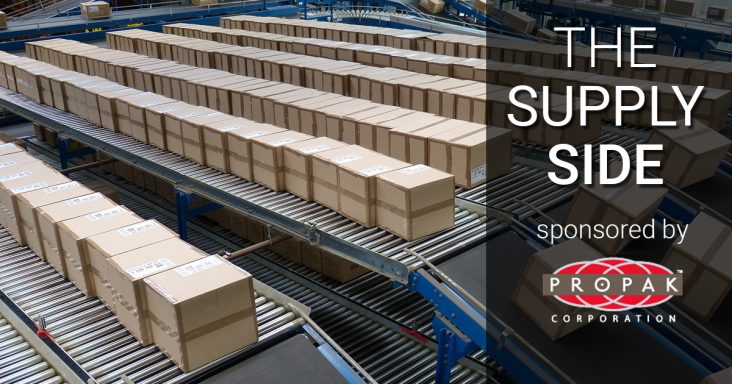The Supply Side: Suppliers prep for shifting consumer patterns in 2022
by January 22, 2022 8:31 am 950 views

Research firm IRI expects food prices to rise an overall 5% in the first half of 2022, though the increases will depend on the grocer and location. In the December report, IRI said that some large companies have already begun implementing additional price increases as inflation rises.
According to the U.S. Bureau of Labor Statistics, economists expect higher prices as overall inflation jumped 6.8% last month compared to a year ago. The U.S. Department of Agriculture food-at-home index released in late 2021 indicated prices rose 6.4% year-over-year. Meat, poultry, fish and egg prices jumped 12.8%, driven higher by increased demand, supply chain disruptions, labor shortages and rising grain costs.
Wells Fargo analysts said price pressures have broadened beyond goods categories, with services inflation starting to reflect the pandemic’s effects on housing costs and medical care. Accelerating service sector prices amid stubbornly high goods inflation has created a challenging environment for consumers and policymakers.
“Looking ahead, we expect to see another solid inflationary gain in December up 7.1% year-over-year. Retail gasoline prices softened in December, and natural gas storage improved relative to its historical trend, setting the stage for a moderate slowdown in energy prices in the near term. Beyond energy, however, we see little scope for a meaningful reprieve with price hikes remaining widespread. Excluding food and energy, which tend to be more volatile on a month-to-month basis, we anticipate a 0.5% increase in the core CPI, which is up 5.4% year-over-year,” said Jay Bryson, chief economist with Wells Fargo Securities.
IRI predicts additional price increases for breakfast meats, frozen poultry and pet food. Kraft Heinz Co. said recently that it would increase prices in 2022 between 6% and 13% more than in 2021. General Mills said last month it planned to raise prices as much as 20% this year on hundreds of products. Price hikes of Annie’s, Betty Crocker and Pillsbury products will take effect in mid-January. That also includes a 20% jump in the cost of cereal brands of Cheerios, Fruit Roll-Ups, Lucky Charms, Trix and Wheaties.
General Mills said it would push along the higher costs for products to retailers, and it looks for them to pass them down to consumers in the first half of 2022.
Tyson Foods also recently said it raised the prices for foodservice customers and retailers in the recent quarter ending Dec. 31. The company’s average beef prices were up 30% over last year, pork prices rose 38% and chicken prices were about 19% higher than a year ago.
Snack food giant Mondelez said last month it planned to raise prices at least 7% in 2022. Oreo cookies, Ritz crackers and Sour Patch Kids will be more expensive this year as the food maker seeks to recoup some inflationary costs in materials and freight. According to CEO Dirk Van de Put, keeping retailers well-stocked with products has been difficult. He noted that on-shelf inventory is “nowhere near where we would like it to be.”
Van de Put said the company expects to see cost inflation jump 6% in 2022 due to higher commodity prices and transportation shortages. He noted that the issues are global but are particularly pronounced in the U.S.
“The average consumer around the world spends 15% more time at home than before the pandemic,” he said. “It happens that these categories, biscuits and chocolate, are also something that is more consumed at home.”
IRI said that while consumer packaged goods (CPG) suppliers will see higher revenue, most expect volumes to be down given the tight labor market and softer consumer demand as income levels decrease in 2022 with the end of stimulus aid that took incomes higher in 2021. IRI expects CPG sales will be down between 1% and 5%, offsetting the rising in revenue. Also, as consumers begin to travel again, IRI expects some spending will shift from food-at-home and go toward other services and non-CPG items.
IRI said suppliers need to watch for price sensitivity as demand will soften at some time in 2022. IRI expects at-home consumption to remain elevated compared to pre-pandemic, but away from home and on-the-go consumption will also increase. The firm said it would be necessary for CPG companies to evolve their product portfolios and sales outlets to continue to retain and win market share.
IRI also looks for balanced growth across pricing tiers, with some retraction in premium-priced items in the back half of 2022. The firm said it would be necessary for brands to leverage their assortments across the private label, branded and premium pricing tiers. The report notes that consumers who tried niche brands in 2020 and 2021 when the branded item was out of stock may not be willing to switch back without a promotion.
Lastly, IRI warns CPG companies against shifting consumer behaviors that saw more online shopping for food and consumables as the pandemic hit. While consumers have said they will return to stores and indeed did so in the recent holiday season, the one area that will continue to resonate with consumers of all ages and demographics is convenience, sometimes even more so than price, according to the IRI report.
IRI said brands must have an omnichannel strategy and set specific role and growth metrics for online and traditional brick-and-mortar shopping segments. With such a strategy, IRI said brands could avoid up to 50% of cross-segment cannibalization while driving strong loyalty and repeat purchases across online segments in what looks to be somewhat challenging 2022.
Editor’s note: The Supply Side section of Talk Business & Politics focuses on the companies, organizations, issues and individuals engaged in providing products and services to retailers. The Supply Side is managed by Talk Business & Politics and sponsored by Propak Logistics.
